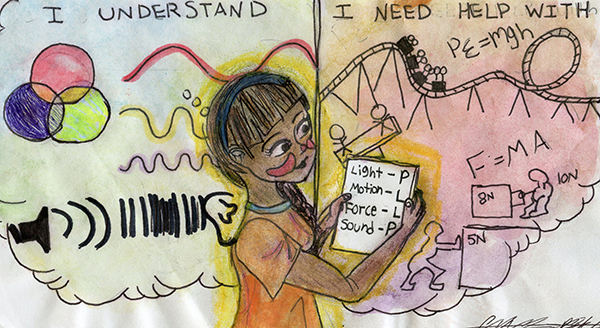Physics classes transition to PLN grading system

illustration by Chaeyeon Park
December 14, 2018
As of this school year, all Physics 163 classes have replaced a numerical grading system with a system involving the use of Ps (proficient) and Ls (learning), according to Physics Teacher Bobby Cowhey. Students are assessed on their conceptual mastery through frequent quizzes in which they receive either a P or an L, rather than a percentage.
Ps and Ls measure the student’s demonstrated understanding, Cowhey says, where a percentage cannot.
“The big idea with the P and L system is that we wanted students to stop focusing so much on collecting points and playing the game of school, as we like to call it, where they are just trying to collect points and they’re not as focused on understanding the material,” Cowhey said.
Physics Teacher Jill Serling explains that in addition to Ps and Ls, teachers can grade an assessment with an N, which is the lowest a student can receive. However, very few students receive Ns, Serling says.
“N has multiple meanings that depend on which teacher you talk to,” Serling said. “[It could mean] needs work, no evidence of understanding, and our N is our 50 percent. If you get Ns the entire year, on every standard you are going to get a 50 percent in our class as an F. However, nobody gets straight Ns.”
Junior Andrew Pappas says that having the lowest possible letter being an N is helpful, as it relieves some pressure from getting any grades below a 50 percent.
“The lowest you can get is only a 50 [percent], so you can’t get any zeros in the class which is good and I think it is an appropriate way to have it,” Pappas said.
Math Teacher Steve Farber says he recently implemented a version of this system in some of his classes in an attempt to stop students from being defined by a number grade.
“There’s a minority of students… who are very concerned about their grades,” Farber said. “They’ve grown up in a system where all they’ve ever known is ‘I’m an 88’, or ‘I’m a 92, what do I need to do, how many points do I need to get to above the threshold, or stay above the threshold?’”
In this system, Farber explains, students are given several assessments on a concept in which they can continually prove their proficiency.
“They will have multiple opportunities to show that they are proficient as opposed to the day that I deem them ready, which I feel for me personally is unfair,” Farber said.
At a certain point, the class will move on to the next standard, however students have the ability to go back and prove proficiency in standards they did not in the past, Farber says.
“It’s okay if you haven’t shown proficiency right away, we’re going to move on and integrate other ideas and you can go back if you need to and show now you’re proficient where you weren’t a week ago,” Farber said. “We will move on whether people are proficient or not.”
Freshman Aria Patel agrees that this system has pushed her to understand the material instead of simply memorizing information for an assessment which a numerical grade often does.
“I’m less worried about the grade that I’m getting in that class and I’m more worried about my understanding of the subject and how everything works instead of just memorizing information,” Patel said. “[I’ve] actually [been able to] see something and figure it out, instead of having to remember a certain factor or formula.”
Despite overall positive feedback from students, Serling believes there is room for improvement in the layout of Powerschool and their compliance with PLN grading.
“We know there are some difficulties with the gradebook and what the screen looks like to a student,” Serling said. “We are hopefully meeting with Powerschool to talk about what they might be able to program to make it what we want students to be able to view. It’s obviously a big ask because that’s a company and the company has people that code to make that screen show up for you, so it would be kind of them catering to what we want.”


